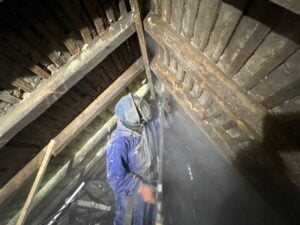How to Remove Spray Foam Insulation Using Dry Ice Cleaning
Removing spray foam insulation can be a daunting task, but using dry ice cleaning can make the process more efficient and less labor-intensive. Dry ice blasting is an eco-friendly, non-abrasive method that can effectively remove spray foam insulation without damaging the underlying surfaces. Here’s a step-by-step guide on how to remove spray foam insulation using dry ice cleaning.
Safety First
Before starting the dry ice cleaning process, ensure you have the necessary safety gear. Wear protective gloves, safety goggles, a long-sleeved shirt, and a mask to protect yourself from dry ice particles and debris.
Step 1: Gather Your Equipment
To perform dry ice cleaning, you will need a dry ice blasting machine, dry ice pellets, and an air compressor. Make sure the equipment is in good working condition and that you have sufficient dry ice for the job.
Step 2: Prepare the Area
Clear the area of any loose items and cover nearby surfaces to protect them from dry ice pellets. Ensure good ventilation to allow the release of carbon dioxide gas produced during the cleaning process. Most loft spaces will be a classed a ‘low oxygen, confined space’. Make sure you contractor has the correct risk assesment in hand to safely complete the process.
Step 3: Set Up the Dry Ice Blasting Machine
Connect the dry ice blasting machine to the air compressor. Fill the machine with dry ice pellets according to the manufacturer’s instructions. Adjust the pressure settings on the machine to suit the type of surface you are working on. Higher pressure is usually needed for harder surfaces, while lower pressure is sufficient for more delicate areas.
Step 4: Begin Blasting
Hold the nozzle of the dry ice blasting machine at a safe distance from the spray foam insulation, usually around 6-12 inches. Begin blasting the foam in a controlled manner, using sweeping motions to evenly distribute the dry ice pellets. The dry ice pellets will sublimate upon contact, causing the foam to become brittle and dislodge from the surface.
Step 5: Remove Dislodged Foam
As the foam becomes brittle and breaks away, use a vacuum cleaner to remove the dislodged particles and any remaining debris. This will help keep the work area clean and prevent the foam from settling back onto the surface.
Step 6: Inspect and Clean
After the bulk of the spray foam insulation has been removed, inspect the surface for any remaining residue. If necessary, perform a final pass with the dry ice blasting machine to remove any stubborn spots. Once all the foam is removed, use a vacuum cleaner to ensure the area is completely clean.
Final Thoughts
Dry ice cleaning is an effective and environmentally friendly method for removing spray foam insulation. By following these steps, you can achieve a clean and residue-free surface without damaging the underlying material. Always prioritize safety, take your time, and be thorough with each step to ensure the best results for your project.



